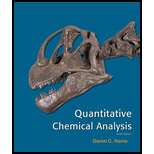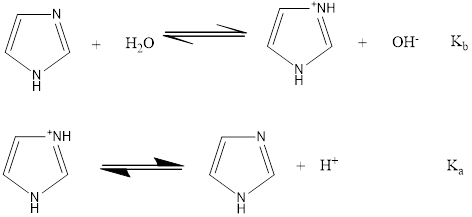
a)
Interpretation:
The
Concept Introduction:
Acid dissociation constant:
Consider a weak-acid equilibrium reaction,
The acid dissociation constant
A weak acid is one that doesn’t undergo completion.
Base dissociation constant:
Consider a reaction of weak base,
The value of
Where
To write the chemical reaction with equilibrium constants
a)
Explanation of Solution
The chemical reaction with equilibrium constants

b)
Interpretation:
The
Concept Introduction:
Henderson-Hasselbalch equation:
Henderson- Hasselbalch equation is rearranged form of acid dissociation expression.
For acid:
Consider an acidic reaction:
The Henderson- Hasselbalch equation for an acidic reaction can be given as,
b)
Answer to Problem 9.41P
The
Explanation of Solution
Given,
Mass of Imidazole =
Mass of Imidazole hydrochloride =
Volume to be diluted =
Formula mass of Imidazole =
Formula mass of Imidazole hydrochloride =
The
The
c)
Interpretation:
The
Concept Introduction:
Henderson-Hasselbalch equation:
Henderson- Hasselbalch equation is rearranged form of acid dissociation expression.
For acid:
Consider an acidic reaction:
The Henderson- Hasselbalch equation for an acidic reaction can be given as,
c)
Answer to Problem 9.41P
The
Explanation of Solution
Given,
Mass of Imidazole =
Mass of Imidazole hydrochloride =
Volume to be diluted =
Volume and Molarity of
Formula mass of Imidazole =
Formula mass of Imidazole hydrochloride =
The
The
d)
Interpretation:
The volume in millimetres that is required to be add has to be given.
To give the required volume to be added in millimetres.
d)
Answer to Problem 9.41P
The required volume that is to be added is
Explanation of Solution
In order to obtain
Because there are
Volume of
The volume that is required of
Want to see more full solutions like this?
Chapter 9 Solutions
Quantitative Chemical Analysis
- Please answer the question for the reactions, thank youarrow_forwardWhat is the product of the following reaction? Please include a detailed explanation of what is happening in this question. Include a drawing showing how the reagent is reacting with the catalyst to produce the correct product. The correct answer is IV.arrow_forwardPlease complete the reactions, thank youarrow_forward
- Consider the synthesis. What is compound Y? Please explain what is happening in this question. Provide a detailed explanation and a drawing to show how the compound Y creates the product. The correct answer is D.arrow_forwardWhat would be the major product of the following reaction? Please include a detailed explanation of what is happening in this question. Include steps and a drawing to show this reaction proceeds and how the final product is formed. The correct answer is B. I put answer D and I don't really understand what is going on in the question.arrow_forwardWhat is the product of the following reaction? Please explain what is happening in this question. Provide a detailed explanation and a drawing showing how the reagent is reacting with the catalysts to product the correct product. The correct answer is B.arrow_forward
- What is the missing intermediate 1 and the final product 2. Please include a detailed explanation explaining the steps of malonic ester synthesis. Please include drawings of the intermediate and how it occurs and how the final product is former.arrow_forwardWhat would be the reagents and conditions above and below the arrow that will complete the proposed acetoacetic ester synthesis? If it cannot be done efficiently, then I will choose that answer. There could be 2 or 4 reagents involved. Please provide a detailed explanation and drawings showing how it would proceed with the correct reagents.arrow_forwardFor benzene, the ∆H° of vaporization is 30.72 kJ/mol and the ∆S° of vaporization is 86.97 J/mol・K. At 1.00 atm and 228.0 K, what is the ∆G° of vaporization for benzene, in kJ/mol?arrow_forward
- The reaction Q(g) + R(g) → Z(l) is shown to be exothermic. Which of the following is true concerning the reaction. it is spontaneous only at High T, it is spontaneous at low T it is nonspontaneous at all T it is spontanrous at all T. it is non spontaneous only at low T.arrow_forwardThe reaction Q(g) + R(g) → Z(l) is shown to be exothermic. Which of the following is true concerning the reactionarrow_forwardWhich of the following has the largest standard molar entropy, S° (298.15 K) He H2 NaCl KBr Hgarrow_forward
 ChemistryChemistryISBN:9781305957404Author:Steven S. Zumdahl, Susan A. Zumdahl, Donald J. DeCostePublisher:Cengage Learning
ChemistryChemistryISBN:9781305957404Author:Steven S. Zumdahl, Susan A. Zumdahl, Donald J. DeCostePublisher:Cengage Learning ChemistryChemistryISBN:9781259911156Author:Raymond Chang Dr., Jason Overby ProfessorPublisher:McGraw-Hill Education
ChemistryChemistryISBN:9781259911156Author:Raymond Chang Dr., Jason Overby ProfessorPublisher:McGraw-Hill Education Principles of Instrumental AnalysisChemistryISBN:9781305577213Author:Douglas A. Skoog, F. James Holler, Stanley R. CrouchPublisher:Cengage Learning
Principles of Instrumental AnalysisChemistryISBN:9781305577213Author:Douglas A. Skoog, F. James Holler, Stanley R. CrouchPublisher:Cengage Learning Organic ChemistryChemistryISBN:9780078021558Author:Janice Gorzynski Smith Dr.Publisher:McGraw-Hill Education
Organic ChemistryChemistryISBN:9780078021558Author:Janice Gorzynski Smith Dr.Publisher:McGraw-Hill Education Chemistry: Principles and ReactionsChemistryISBN:9781305079373Author:William L. Masterton, Cecile N. HurleyPublisher:Cengage Learning
Chemistry: Principles and ReactionsChemistryISBN:9781305079373Author:William L. Masterton, Cecile N. HurleyPublisher:Cengage Learning Elementary Principles of Chemical Processes, Bind...ChemistryISBN:9781118431221Author:Richard M. Felder, Ronald W. Rousseau, Lisa G. BullardPublisher:WILEY
Elementary Principles of Chemical Processes, Bind...ChemistryISBN:9781118431221Author:Richard M. Felder, Ronald W. Rousseau, Lisa G. BullardPublisher:WILEY





